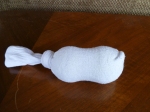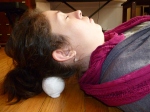 How you talk to your body matters. I am not talking about society driven gender norms, although, they are not entirely separate from this conversation.
How you talk to your body matters. I am not talking about society driven gender norms, although, they are not entirely separate from this conversation.
As a massage therapist, I constantly hear people refer to their bodies in less than positive terms. People apologize to me for being overweight, not shaving their legs, having moles. I have a client who told me, “I hate my left shoulder. I mean, my left shoulder is a real bastard. No one can figure out what’s wrong with it. Nothing helps. MRIs, PTs, energy workers, massage therapists, orthopedic surgeons–no one can find anything wrong with it. If I could have you cut it off, I would. That is how much I hate my left shoulder.” This kind of commentary is not uncommon. “Maybe try saying you love your left shoulder?” I suggested, suddenly feeling a bit self conscious of how hippy-like I sounded. But, that was my honest reaction. “Maybe stop saying how much you hate it and want to hurt it and it may let off on hurting you.” Don’t get me wrong. I don’t believe this dude was making up his pain, his pain was undeniably real. But, he was leaving his body absolutely no room for improvement; cutting off any possibility of change before it could manifest, and was asking that I join in on the hatred. The second you start condemning a piece of you as dysfunctional or unworthy, it will start to act as if that is the truth. This is something we do over the course of years. Think about it. If you tell a child they are stupid once, they may not believe you. But, say it to them a billion times, and usually the outcome is unfortunate and predictable. A child will hold on to the verbal trauma inflicted by parents, teachers, and other kids. This is true. If it weren’t, we wouldn’t have psychotherapy as a profession. Your body is no different from a child’s mind. Brutally honest, reactionary, and always moving toward love; your body will curl inward protecting itself from the emotional onslaught of the world around it, and most especially from the world that is created within it. Your left shoulder can’t decide to move to New York City, take shrooms, and flip you off for making it miserable. So: it gets painful and angry. And, in my non-scientific opinion, is more prone to injury, due to lack of awareness and the shutting down any other possible experience other than pain in that part of the body.
There is a lesson to be learned from everything. I am not one of those people who smiles brightly as you sit there will a broken ankle telling you that everything happens for a reason. I am the person that says, “That really sucks that you broke your ankle. Now, let’s get to work.” There will be physical pain, but also frustration, anger, and maybe even grief over an injury. But, becoming friends with your ankle is profound and healing in the same way as reconciling with an estranged family member can be. It isn’t perfect. It isn’t pretty. But, dammit, there is love there and getting to a place where you can express that is pretty fucking amazing.
SO, how does one go about shifting how the body is thought and talked about? Well, we can know that something is correct, but knowing it intellectually does little to change our habits. You can know smoking is bad for you, but unless you experience the act of quitting–actually throwing them out and not lighting a cigarette–you won’t understand what it means to not smoke. Same thing here. You can say to yourself, “Yes, this sounds reasonable. I should start telling my left shoulder that I love it instead of that I hate it.” But, unless you wake up every single day and make a conscious effort, no change will occur. Then, you will likely just beat up on yourself even more for not making the desired changes. Trust me, I am an expert at this.
The first step is just to be aware when you are thinking or saying something about your body that is confining, leaving you no opportunity for growth. Just recognize it. Say to yourself, “Hmm, that’s interesting. I didn’t realize I said xyz about my right big toe.” Continue with that for a long time, maybe months. Become aware of the situations where that attitude pops up. I always would talk about how horrible my left foot was when trying on shoes. I would tell the sales girl that I had a “gimpy” left foot and needed some serious arch support due to an injury when I was twelve years old. Oh, and bring two different widths because my Sasquatch of a left foot was unpredictable and I almost always needed a wide width just for that foot. Same thing with buying eye glasses. I would try to be cute and quirky and tell the sales person I needed the section for “big and tall heads” because I do have a wider face and most glasses just do not fit. Yes, it is true that my face is wide and yes it is true that my left foot is different from my right foot. But, the way I condemned my left foot set the stage for me to disconnect myself from that part of my body, inviting more injury. I went through orthodics, discussions on surgical solutions with podiatrists, everything except accepting my left foot as it was and opening up to the possibility that it could change for the better. I’m not saying that orthodics and surgery are not helpful or needed in many cases, they are tools in the toolbox. But, by thinking about my foot as permanently damaged, whose only direction would be one of decline; I had already eliminated any other possible outcome.
The second step is, once you have a good flow of recognizing when and in what situation it happens, the see what happens if you just choose not to say accusatory things about your body in those situations. What would happen if you didn’t point out your weight while trying on swimwear? What would happen if you didn’t refer to your “bad” shoulder, or your “trick” knee, or your “gimpy” foot in those terms? The same old thoughts will likely pop up in your head. Note them, there they are. Now, what happens if you just don’t verbalize what your mentally telling yourself? Now, to change the mental habit, start to imagine your shoulder/ankle/foot/knee just wants you to hold it, tell it everything is okay, that it is loved. Smile at your foot. Smile at your knee.
After this goes on for a while, you will become more accustomed to smiling at your knee, and it won’t seem weird at all. You will start to notice a moment or two before it “gives out,” and might be able to adjust your gait in time. You will get to know your knee, figure out what it wants, needs, likes, dislikes. You will have a love affair with that knee and therefore be more open and available to the rest of your body. In those pictures of 90 year olds amazingly doing crazy yoga moves, or still doing gymnastics, or running a marathon–do you think they get up in the morning and decide that their body is incapable and defective? My guess is that they listen to what their body is saying and know what they can and cannot do without worrying what that says about them as a person.
Have unconditional love for your body, and it may just love you back.
I will leave you with some great quotes from some great teachers .
Forgive me for paraphrasing; Lindy Ferrigno, a shiatsu practitioner for the last forty years once said, “Science has shown that the human body has about as many cells as there are stars in space. Science has also proved that we have much more space between cells than cells themselves. So, when you think about it, we only appear to be solid. In reality, we are more space than stars. It is there I focus my attention when working with the body, on creating more space.”
“Smile at your vehicle.”–Chris Ray,
“Body problem, body solution. Body question, body also answer. Lucky, you have good body teacher.” –Pichet Bonthumme,
Changing the way you think and talk about yourself translates to how you think and talk about others as well, but that is a post for another time.
An experiment on the language of love.








